-
Posts
270 -
Joined
-
Last visited
Content Type
Profiles
Forums
Store
Help Articles
Posts posted by Baron d'Apcher
-
-
9 minutes ago, donk79 said:
Beautiful! Do you have plans for how they will be served?
Peel off the skin and enjoy on toast, with warm potatoes or however you enjoy pickled fish.
Making fish sauce with all the carcasses.-
 3
3
-
 1
1
-
-
-
It is what Americans call the Denver steak. Part of the chuck roll.
-
 1
1
-
 1
1
-
-
Could be the start of white bloom (penicillin nalgiovenes) which is perfectly fine.
Use metric measurements by weight in the future. Far more reliable.
Consider beef middles instead of hog casings and make them shorter.
Soak the casings in Mold 600 and you will get a thick white bloom.
-
 4
4
-
-
On 8/25/2022 at 5:20 PM, JeffGC said:
I had a rather lengthy conversation with someone at American Association of Meat Processors. Nelson suggested “The Meat Buyer’s Guide (North American Meat Institute).” The restaurant is misrepresenting the product.
Thanks to everyone for responding.
Jeff C.
Misrepresenting the product is a lengthy way to say fraud.
However, a bone-in ribeye from a commodity steer for 1 person is a huge amount of meat. 2-3lbs raw. What size is the ribeye described as? If the restaurant is buying 109 ribeye's, it is entirely possible that they are cutting in between the bones to get more portions and the bones are from the chine, which run in between the ribs.
For what it is worth, I always remove chine remnants from bone-in ribeye's. They are an unpleasant choking hazard.
-
 3
3
-
-
17 hours ago, heidih said:
That looks like presskopf which is sort of a headcheese-sausage hybrid that is cooked in a large diameter casing. The parts of the head are brined, diced & ground, stuffed into a casing, smoked and poached.
-
 3
3
-
-
1 hour ago, heidih said:
So how does a Bauernwurst/farmers wurst differ from a country pate?
Anything "wurst" is a sausage and there are quite a few varieties of Bauer. Bauerwurst is a coarse ground sausage, smaller than Bauernwurst, which is smoked pork & beef but I'm confident there are fluctuations by region, town, personality and temperament. Bauernleberwurst is invariably put in a casing raw and not much different than liverwurst, except that liverwurst has more liver and is generally eaten cold.
Headcheese qualifies as a terrine. The parts of the head are cooked first, diced up and then put in a mold with some very gelatinous juices which makes it nice and firm. Scrapple is also a sort of terrine. Cooked parts of the head ground up with raw liver and then the paste is cooked with buckwheat or cornmeal until thick and left to cool in a mold.
-
 4
4
-
-
1 hour ago, Shelby said:
I wish I had some cool shaped molds, but I only have loaf pans.
Scour Ebay, tag sales and antique stores. Most of the shaped molds just aren't made that much anymore.
-
 1
1
-
 1
1
-
-
3 hours ago, Duvel said:
Thanks, @Baron d'Apcher. So, you‘d make the distinction that pâtés are assembled raw and binding occurs via the cooking process, while terrines are assembled from already cooked ingredients and binding does happen via the gelatine-rich juices ?
Correct. To wit, terrines involve layers or vegetables or fish and more commonly braised beef shanks, chicken or ham (Jambon Persillé).
-
 1
1
-
 1
1
-
-
For what its worth, the aforementioned chicken liver pâté is not so much a traditional pâté since the mixture is cooked, processed (finely mixed) and then put in a container whereas pâtés are typically cooked in a mold or vessel from raw. That doesn't diminish the gustatory quality at all. Chicken liver parfait however are cooked from raw in a jar or mold. A preparation that is cooked and then put in a mold or whatnot is generally called a terrine
To the French charcuterie purists, chicken liver pâté is commonly referred to as a "farce à gratin" which is either served on its own and billed as a "mousse" or incorporated into other forcemeats (country style pâté) as a binder. I think of a bonafide pâté as a forcemeat varying in coarseness that is generally cooked in a mold, like the venerable "Country pâté". "Pâté Grand-mère" (grandmother) is a thriftier version characterized by a higher amount of livers and stale bread.
My chicken liver spread consists of chicken livers marinated in gin, onions, button mushrooms, chicken fat, honey, sherry vinegar and spices. I fill jars and then cover them chopped up pickles and confit gizzards (or tomatoes in the summer) and then a layer of aspic.
-
 12
12
-
 6
6
-
 2
2
-
-
Gastronomy is something like the distilled delineation of all elements that provide the highest standard of nourishment. I'd propose "satisfaction" as it pertains to the ritual of eating. 19th Century gastronome Grimod de la Reynière documents the choicest ingredients by season and location in his expansive and infinitely charming "Almanach des Gourmands", followed by Brillat-Savarin's epicurean treatise on gustatory aphorisms. Both are founding experts in the matter.
-
 2
2
-
 1
1
-
-
Poach the foie gras ahead of time and chill. American foie gras is much fattier than the French counterparts and are prone to releasing far too much fat.
Buy "B" lobes as they are smaller, and slightly cheaper, than the "A" lobes which are absurdly massive and look like what I imagine David Crosby's liver to be.
-
 3
3
-
-
Natural casings might help firm up the product as it will shrink. Craft Butcher's Pantry is a reliable source for natural casings of all sorts, shapes and sizes.
-
 1
1
-
 1
1
-
-
Consider cutting the shank and simmering with beans until both are tender, like cassoulet.
For Swedish Christmas I deboned 2 shoulders, wrapped them in caul fat* nice & snug with herbs and braised until tender with root veg and chicken (or lamb) stock fortified with roasted bones.
*Wrap the shoulder tightly in heavy-duty tin foil like a Tootsie pop and chill in the freezer until firm, easier to wrap.
Pic is everything raw. The shoulders and veg were browned in bacon fat and braised uncovered @250F, flipped every 1/2 hour until tender and the strained sauce was finished with a splash of Sherry vinegar, dried cranberries and chestnuts.
-
 8
8
-
 1
1
-
-
7 hours ago, JoNorvelleWalker said:
Interesting that in his new book, Secrets of the Butcher, Arthur Le Caisne calls for an oven and hermetically sealing the braising pot with dough. The meat in this method sits above the braising liquid.
That is curious. A proper braise is a mixture of wet and dry heat: an item in an uncovered pot in an oven that is half-way covered with liquid. The dry heat allows for caramelization and evaporation and rotating the item adds caramelization to the liquid (deglazing it) and repeats anew. The continued caramelization and reduction is what enriches/concentrates the liquid (eventually the sauce). An hermetically sealed pot steams with no reduction and the temperature continues to increase, like impromptu pressure cooker without the release.
Adding less liquid will invariable keep the meat above the braising liquid.
-
 2
2
-
-
Use plainly ground pork and season according to your tastes.
-
 2
2
-
-
8 hours ago, Nancy in Pátzcuaro said:
Another way to get tough beef is to run cattle around before slaughter. Feed lots, where they stand around eating and pooping, creates more tender beef. So if you buy a whole cow from some producer, make sure it didn't get chased through the pasture for an hour before they caught it.
Not really. If feedlot steers (we rarely eat cows) don't move, it is because they don't have enough room to do so and they are young: generally Angus breed around 24 months or younger. Feedlot beef represents about 97% of US beef production and while most of it will qualify as "tender" it is more a result of young animals whose musculature is not fully developed, having been quickly and somewhat artificially brought to market weight (1200lbs or so) by finishing them with corn, which they enjoy but don't know that they are not designed to properly digest it (it makes them sick). The corn is heavily subsidized, reliant on pesticides which flow into the ground or downstream to the Gulf of Mexico (killing lots of fish) and generates beef that is nutritionally deficient compared to 100% grass-fed. Corn-fed feedlot beef is terrible for the animals and terrible for the environment. It (and other CAFO's) is the scourge of meat production and highlights an American affinity for abundant crap over quality and integrity.
-
 2
2
-
-
On 11/5/2018 at 6:12 PM, kayb said:
But one of the several reasons I've gone to exclusively locally grown, small-farm-raised beef, pork and chicken is that at least I know that creature lived a pleasant life before it met its demise.
Agreed. I work and live on a 28 acre family owned farm that pasture-raises pigs, chickens (both fed certified organic feed) and lamb (grass-fed) but invariably any pork/beef/lamb has to be slaughtered in a USDA facility for retail sale (chicken can be exempt with the certain requirements). Slaughter is a considerable determinant in the final product. An animal can live a cherished life but be clumsily killed resulting in a mediocre product. Finding careful staff to work in a slaughterhouse is a challenge and it is not a job many aspire to have. As result, animals are often dispatched in a careless manner, which is unfortunate.
Paying a premium for a product has its merits up and down the life-cycle of food animals.
Slaughter is the most overlooked aspect of meat.
-
 7
7
-
 1
1
-
 1
1
-
-
Dark cutters are generally bovine (beef) and occasionally other ruminants like sheep and goats. The color is indeed burgundy/purple and is an indication of stress or too high of a temperature prior to the slaughtering. Pigs with PSS (porcine stress syndrome) under similar pre-slaughter conditions present PSE (pale, soft extrudative) meat and often darker firmer red meat. Chickens however are not red meat like bovines and any surface bruising/bleeding was likely during the slaughtering process prior to it being bled. Purdue (and other large producers) suffocates the birds with carbon dioxide or argon gas before bleeding them.
Sadly, super affordable prices come with significant consequences for the animal, the consumer and the environment.
-
 4
4
-
 1
1
-
-
There isn't much juice worth the squeeze once the jowls and cheeks are removed, certainly not worth making pâté or anything that would resemble it since you are left with mostly skin (collagen) and a minuscule amount of meat in the snout or behind the skull.
Consider removing whatever skin is left, blanch it to get whatever impurities out, scrape the excess fat off and cook beans or hominy with the skin. The skin will thicken the bean/hominy cooking liquid and you will be on your way to cassoulet or posole.
Do you still have the tongue?
-
 1
1
-
-
2 hours ago, FeChef said:
Let me rephrase my original question. Why does retail cured bacon have a longer shelf life then the same bacon cooked to crispy bacon? Basicly bacon jerky. Beef jerky lasts months in a fridge, so why should i throw the crispy cooked bacon away after 4-5 days like every website suggests?
Food safety authorities err to the side of caution and can not presume how much water activity is in the crispy bacon (level of doneness), or the conditions in which is was cooled or left out on the counter or whatnot. To protect themselves from lawsuits and such, regulators limit the shelf life of products that spend time unrefrigerated and below 141F where spoilage can occur. The regulations are often excessive: chicken doesn't really need to be cooked to 165F. Pancetta lasts a very long time, but the USDA gives it a mere 7 day refrigerated shelf life, which is absurd.
Beef jerky is very different than bacon. First and foremost, beef jerky is a dried, shelf stable item that does not need refrigeration based on the high salt and low water.
Of course you could freeze the cooked bacon or cook less to begin with.
-
 3
3
-
-
16 hours ago, gfweb said:
But the fat is unrendered. Are we talking about different things...canadian vs american bacon?
I am not sure what the experiment is, but hard fat (back fat) will not render at 140F. Soft fat (leaf lard) will. And a thin slice of bacon acts much differently than a full slab of whole belly.
When shoulders are smoked for a very long time on the cusp of 180F, much of the hard fat is still there, albeit it very tender.
Thinly sliced hard fat will render at higher temp, like in a 350F over or hot frying pan.
Crisped bacon (because slab bacon is, for the most part, already cooked) has much less water than the un-crisped/un-rendered slice and consequently will last a very long time in the fridge. The USDA recs are paranoid fantasies meant to insulate themselves from worst case scenarios since the US food system (poultry in particular) puts the safety onus on the consumer. I coarsely grind up bacon ends, render them stove-top, strain them, crisp them in a very low oven overnight and the bacon bits last for months in the fridge.
Bacon has lots of salt and nitrates specifically meant to increase the shelf-life.
The "uncured" Niman Ranch bacon most definitely has nitrates in the form of celery powder (which has more ppm than the conventional Prague #2 cure) but because celery powder has varying levels of nitrite and has to be used in such minuscule quantities, the USDA does not recognize it as a curing agent and forbids the "cured" distinction, even though it certainly is. Its all marketing malarkey.
-
 3
3
-
-
1 hour ago, gfweb said:
But what about the stuff you buy in the supermarket? That's uncooked and smoked, no?
Most of the stuff you buy in the supermarket is smoked and cooked to an internal temp of about 140F or somewhere close in massive ovens.
-
20 hours ago, FeChef said:
Why does raw cured bacon have a longer shelf life in the fridge then cured cooked bacon? I always bake a pound and freeze for quick reheat in the microwave but the slices can be a pain to separate when frozen. I was suprised to read the fridge shelf life was 4-5 days? That seems odd to me.
Who or what says so? Invariably, bacon is fully cooked during the smoking process, or else it isn't bacon. Cooked bacon will last a very long time in the fridge.



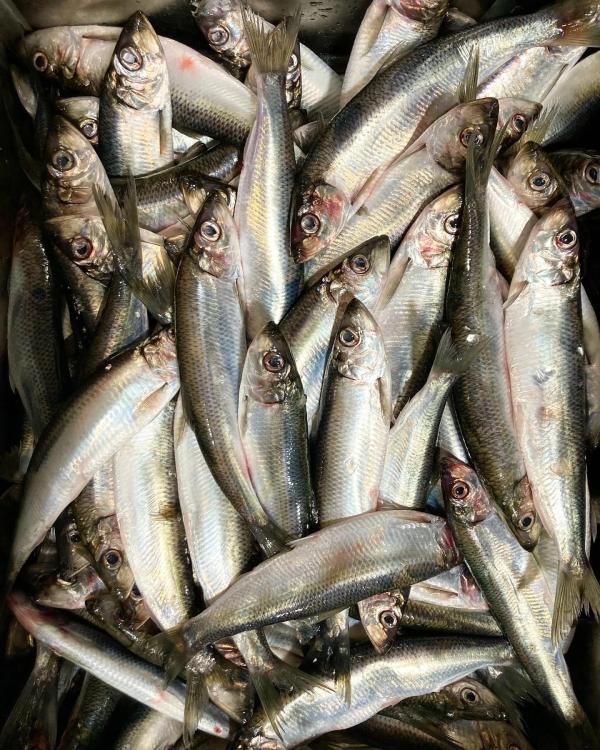
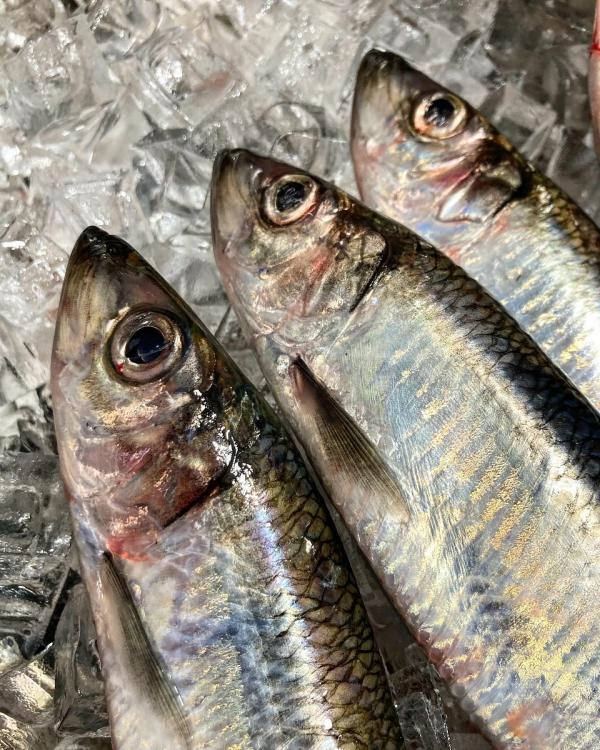

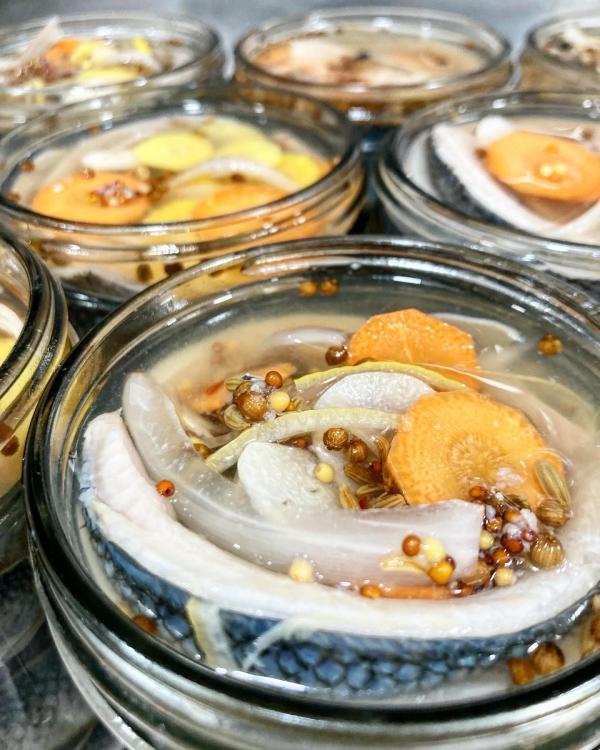
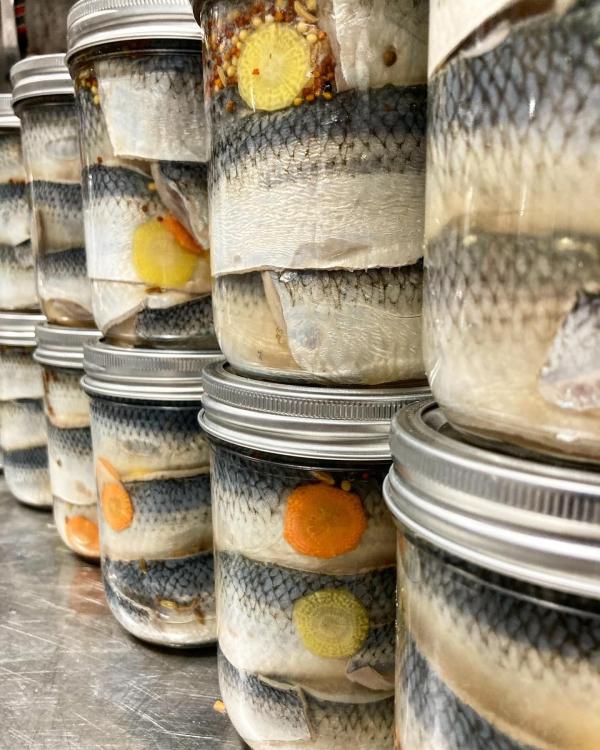

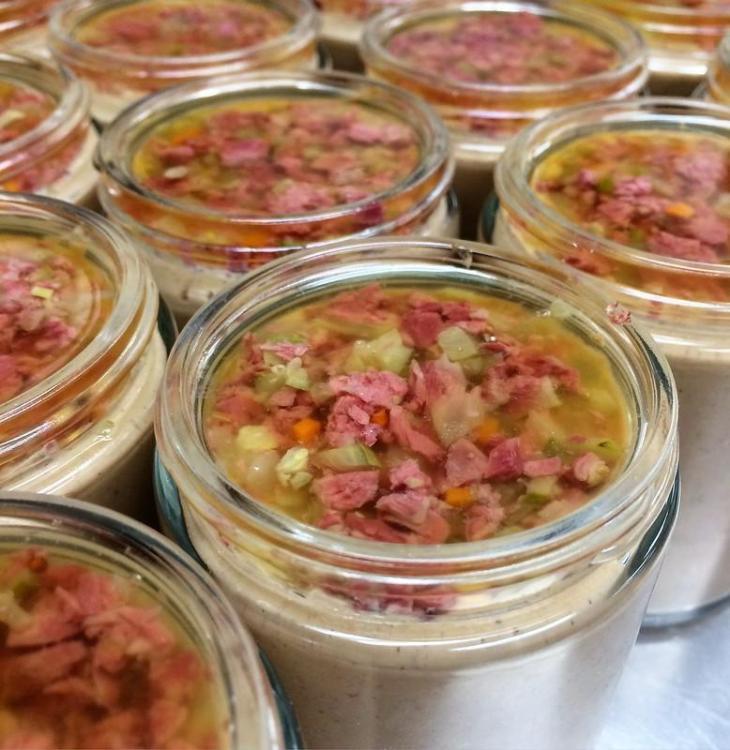

What Are You Preserving, and How Are You Doing It? (2016–)
in Cooking
Posted
Fish are filleted and brined in a 10% salt brine for 3 hrs. Rinsed in cold water and cold pickled in 3% salt, 3% cane sugar brine (90% white wine vinegar, 10% white wine), spices and some veg.
The skin peels off easily.